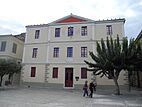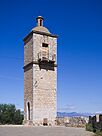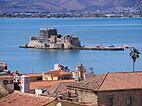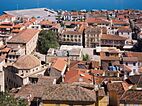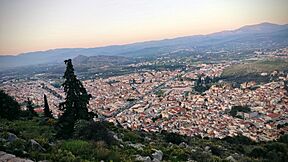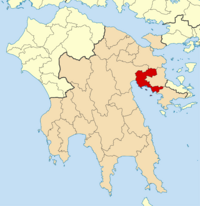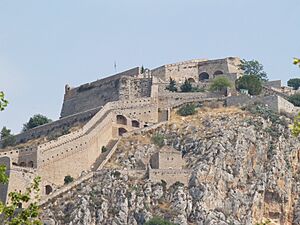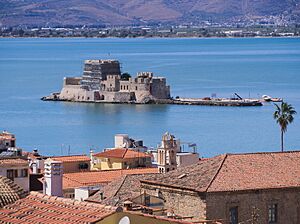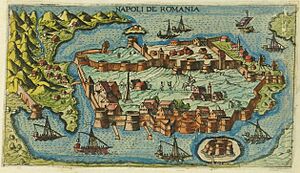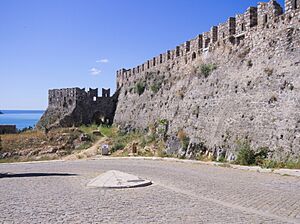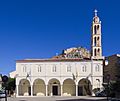Nafplio facts for kids
Quick facts for kids
Nafplio
Ναύπλιο
|
|
|---|---|
|
Clockwise from top right: Palamidi Fortress, Acronauplia Clock Tower, Nafplio Old Town, Constitution Square, Bourtzi Castle, Othonos Street, Nafplio Town Hall. Bottom of the photo of the central square of Nafplio: View of Nafplio and the surrounding areas.
|
|
| Country | Greece |
| Administrative region | Peloponnese |
| Regional unit | Argolis |
| Area | |
| • Municipality | 390.2 km2 (150.7 sq mi) |
| • Municipal unit | 33.62 km2 (12.98 sq mi) |
| Elevation | 10 m (30 ft) |
| Population | |
| • Municipality | 32,625 |
| • Municipality density | 83.611/km2 (216.551/sq mi) |
| • Municipal unit | 19,375 |
| • Municipal unit density | 576.29/km2 (1,492.59/sq mi) |
| Community | |
| • Population | 14,532 ({{{population_as_of}}}) |
| Time zone | UTC+2 (EET) |
| • Summer (DST) | UTC+3 (EEST) |
| Postal code |
211 00
|
| Area code(s) | 2752 |
| Vehicle registration | ΑΡ |
| Website | www.nafplio.gr |
Nafplio (pronounced Nahf-plee-oh) is a beautiful coastal city in Greece. It is located in the Peloponnese region. Nafplio is the main city of the Argolis area and a very popular place for tourists to visit.
This city has a long and interesting history. It was founded thousands of years ago. In the Middle Ages, it became an important port. Nafplio was even the capital of Greece for a short time, from 1827 to 1834.
Contents
The Name of Nafplio
The name of this city has changed many times over the years. Today, it is called Nafplio in modern Greek. In English, you might also hear it called Nauplia or Navplion.
One of the oldest mentions of Nafplio is from ancient Egypt. It appeared on a list from the 14th century BCE.
In ancient times, the city was known as Nauplia in Greek and Latin.
During the Middle Ages, people used names like Náfplion or Anáplion.
When the Venetians ruled the city, they called it Napoli di Romania. This name helped tell it apart from Naples in Italy. "Romania" was a old name for the lands of the Byzantine Empire.
Later, when the Ottomans took over, they called it Mora Yenişehir. "Mora" was a name for the Peloponnese, and "yeni şehir" means "new city" in Turkish. They also called it Anabolı.
In the 1800s and early 1900s, people used both Náfplion and Nafplio in modern Greek.
Geography of Nafplio
Nafplio is located on the Argolic Gulf in the northeast Peloponnese. Most of the old town is on a piece of land that sticks out into the gulf. This creates a natural bay that is safe for ships.
The city was once surrounded by marshes. But since the 1970s, new land has been created. This has almost doubled the city's size.
Nafplio Municipality
The larger area around Nafplio is called the Municipality of Nafplio. It was formed in 2011 by combining four smaller areas:
- Asini
- Midea
- Nafplio
- Nea Tiryntha
The total area of the municipality is about 390 square kilometers. The main part of Nafplio city is about 33.6 square kilometers. The city of Nafplio itself includes the communities of Nafplio, Aria, Lefkakia, and Pyrgiotika.
Population Growth
| Year | Community | Municipal unit | Municipality |
|---|---|---|---|
| 1991 | 10,611 | - | - |
| 1991 | 10,897 | 14,704 | - |
| 2001 | 13,802 | 16,885 | - |
| 2011 | 14,200 | 18,910 | 33,356 |
| 2021 | 14,532 | 19,375 | 32,625 |
History of Nafplio
Ancient Times and Myths
The area around Nafplio has been lived in since very old times. You can still see some ancient walls on the Acronauplia hill. The city was a strong fortress many times in ancient history.
According to Greek myths, Nafplio got its name from Nauplius. He was the son of Poseidon, the god of the sea. Some stories say the first people in Nafplio were Egyptians who came to Greece.
Nafplio was once an independent city. It was an important port for the nearby city of Argos. Later, Argos took control of Nafplio. By the 2nd century AD, the city was mostly deserted.
Byzantine and Frankish Rule

The Acronauplia hill has walls that are even older than ancient Greek times. Over the centuries, different rulers added to the city's defenses. These included the Byzantines, the Franks (from Western Europe), the Venetians, and the Turks.
In the Middle Ages, Nafplio became very important. In 1212, French Crusaders took over the city. It was later sold to the Republic of Venice in 1388. The Venetians thought Nafplio was one of their most important places in the East. They made the lower city bigger and stronger.
Venetian and Ottoman Control
The Venetians ruled Nafplio for a long time. During this period, the city successfully defended itself twice from Ottoman attacks. But in 1540, the city finally surrendered to the Ottomans. They renamed it Mora Yenişehri.
The Venetians took Nafplio back in 1685. They made it the capital of their "Kingdom of the Morea." To make the city even stronger, they built the huge Palamidi castle. This was one of the last big castles the Venetians built overseas. However, only a few soldiers were left to defend it. The Ottomans easily took it back in 1715.
Palamidi castle is on a hill above the old town. It played a big role in the Greek War of Independence. Greek forces captured it in November 1822.
Greece's First Capital
During the Greek War of Independence, Nafplio was a major Ottoman stronghold. The Greeks surrounded it for over a year. The city finally gave up because people were starving.
After it was captured, Nafplio became the temporary capital of the new Greek government. This was because of its strong defenses.
Ioannis Kapodistrias, the first leader of independent Greece, arrived in Nafplio in January 1828. He made it the official capital of Greece in 1829. Sadly, he was assassinated in Nafplio in 1831. After his death, there was a period of disorder.
Then, King Otto arrived and established the new Kingdom of Greece. Nafplio remained the capital until 1834. That's when King Otto decided to move the capital to Athens.
Nafplio Today
After the Greek Civil War, tourism became very important for Nafplio. It was one of the first places in mainland Greece to become a popular tourist spot. Today, it's one of the most visited cities in Greece. Many tourists come from Athens and other Greek cities. Visitors also come from Germany, France, Russia, and the United States.
Nafplio is popular all year round. This is because of its beautiful buildings, its closeness to Athens, and its mild weather. It's a favorite spot for weekend trips.
Besides tourism, farming is also important. The area around Nafplio has fertile land. Farmers grow oranges, lemons, peaches, olives, and almonds. The port of Nafplio is used for shipping goods and for many leisure boats.
{{wide image|Nafplion Greece.jpg|550px|align-cap=center|Plateia Syntagmatos, also known as Constitution Square.]]
Getting Around Nafplio
Bus Services
Since 1952, Nafplio has had public bus services. These buses connect the city to other places in the region. They also go to major Greek cities like Athens. A bus trip to Athens takes about two hours.
Train Services
Train service in Nafplio started in 1886. The old train station building is still there.
Nafplio is connected by a short train line to Argos. In 2011, the train service was stopped. This happened during a time of financial difficulty in Greece. The Peloponnese region is now trying to get money to bring back and improve the train line.
Architecture and Buildings
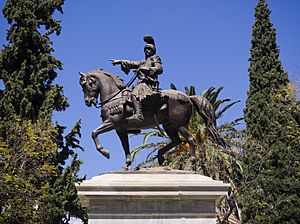
Acronauplia is the oldest part of Nafplio. It used to be a separate town. When the Venetians and Franks arrived, they made it part of the city's defenses. Other important forts include Palamidi and Bourtzi. Bourtzi is a small castle in the middle of the harbor.
Nafplio has a special traditional architectural style. Many colorful buildings in the old town show Venetian influences. This is because the Venetians ruled the city for many years. The city also has many neoclassical buildings.
You can find several sculptures and statues around the city. Most of these are related to Nafplio's modern history. For example, there are statues of Ioannis Kapodistrias, King Otto of Greece, and Theodoros Kolokotronis.
City Areas
- Gyalós
- Kourti
- Old town
- Psaromachalas
- Prónoia (a planned area)
Culture in Nafplio
Local Food
Some special local dishes you might try include:
- Goglies (Goges), a type of pasta.
- Striftades/Striftaria, handmade pasta.
- Giosa, a lamb or goat meat dish.
- Bogana, lamb meat with potatoes.
Museums to Visit
- Archaeological Museum of Nafplion
Education
Since 2003, the University of Peloponnese has a School of Fine Arts in Nafplio. It has a Department of Theatre. Here, students can study:
- Acting and Directing
- Dance
- Set and Costume design
- Theatrical Studies
Famous People from Nafplio
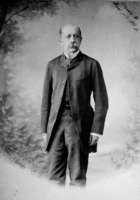
Many notable people have connections to Nafplio:
- Nicolas "the Greek" (lived 1519–1522), one of the few survivors of the first trip around the world.
- Tellos Agras (1880–1907), a Greek fighter.
- Leonidas Drosis (died 1882), a sculptor.
- Nina Bawden (1925–2012), a writer who lived in Nafplio.
- Charilaos Trikoupis (1832–1896), who was the Prime Minister of Greece seven times.
- Panagiotis Tachtsidis (born 1991), a football player.
International Connections
Twin Towns and Sister Cities
Nafplio is twinned with several cities around the world:
|
Consulates in Nafplio
The city also hosts honorary consulates for these countries:
Sports
- Pannafpliakos F.C., a local football club.
Images for kids
-
The church of Saint Nicholas.
-
St. Spyridon church, where Ioannis Kapodistrias was murdered.
See also
 In Spanish: Nauplia para niños
In Spanish: Nauplia para niños


